Vijay Jayaraj
Steel is vital in modern society, providing us with homes, factories, bridges, vehicles, and a variety of other machines and infrastructure. Global crude steel production has doubled since 2001, and demand will continue to grow in the coming decades.
Amid the climate-obsessed rush to “decarbonize” heavy industry, hydrogen-based steelmaking is touted as a “clean” alternative to traditional coal-based steelmaking processes. With seemingly little thought, policymakers, environmentalists and some industry leaders are pushing hydrogen fuel manufacturing with the same enthusiasm once reserved for solar panels.
However, the shift to hydrogen steelmaking could undo a century of progress in efficient production. The high cost, technical challenges and limited scalability of the hydrogen-based process destined to make it less viable than coal-reliant steelmaking.
The evolution of steelmaking efficiency
The steel industry has always been the cornerstone of industrial development, and its development process has witnessed human ingenuity and technological progress. In the early 20th century, the introduction of oxygen converters revolutionized steel production.
Over the decades, continuous improvements in blast furnace technology, process control and energy recovery have led to significant improvements in productivity and energy efficiency. China continues to dominate in terms of production capacity and exports, with industry giants such as Baowu Group at the forefront. Other important steel producers include Japan's Nippon Steel & Sumitomo Metal Corp, India's Tata Steel, South Korea's Posco and Europe's ArcelorMittal.
Today's integrated steel plants are engineering marvels, capable of producing millions of tons of steel every year with remarkable efficiency. The best-performing blast furnaces can achieve energy efficiencies of up to 70%, a figure that seemed unachievable just a few decades ago. The risks of abandoning this tried-and-true approach in favor of relatively untested hydrogen-based processes cannot be overstated.
Dangers of Hydrogen Steelmaking
Hydrogen-based steel production, particularly the direct reduced iron process using hydrogen, is considered a solution to climate change. But producing so-called green hydrogen from “renewable” energy sources can cost twice as much as coal.
Conservative estimates suggest that hydrogen-based steel production costs could be 20-30% higher than traditional methods. This cost difference is not insignificant in an industry with razor-thin margins and fierce global competition.
The increased costs will ripple throughout the economy, affecting construction, car manufacturing and countless other industries that rely on cheap steel.
Rystad Energy He said that only by imposing heavy taxes on coal and steel or providing huge subsidies to steel manufacturers can “green” steel be competitive.
In addition, hydrogen produced through electrolysis is energy intensive. To produce sufficient output to meet the needs of the steel industry will require a massive expansion of renewable energy capacity, well beyond current projections.
Although pilot green hydrogen projects exist, they have yet to be proven on an industrial scale. In comparison, one of the most significant advantages of coal-based steelmaking is its ability to operate on a large scale.
Modern blast furnaces can produce up to 400 tons of steel per hour and can operate continuously for several years during major maintenance periods. This scale of production is critical to meeting global steel demand, which will be 1.95 billion tons in 2021 and is expected to grow.
Abundant coal and mature supply chains make this sustained level of production possible. The industry's infrastructure for coal mining, transportation and steelmaking has been developed and improved for more than a century and is capable of supplying about 1 billion tons of coal to the steel industry every year.
Hydrogen-based steelmaking, on the other hand, is an even more ridiculous proposal from those fear-mongering about global warming, which would actually have no effect on the planet's temperature but would slow down economic growth and infrastructure development in the modern world.
This review was first published on Real and clear market August 23, 2024.
Vijay Jayaraj is a research and scientific assistant CO2 AllianceArlington, VA. He holds a master's degree in environmental science from the University of East Anglia, UK, and a postgraduate degree in energy management from Robert Gordon University, UK
Relevant
